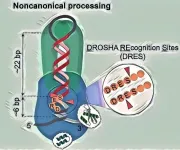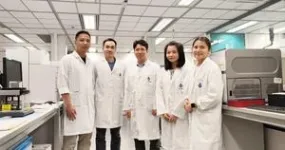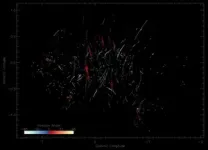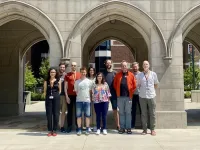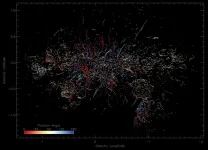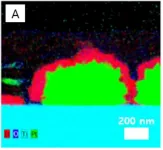(Press-News.org) To discover and thoroughly demonstrate the newly identified noncanonical cleavage mechanism, the Hong Kong University of Science and Technology (HKUST) research team, led by Prof. Tuan Anh Nguyen, Assistant Professor of the Division of Life Science, used several sophisticated techniques, such as miRNA sequencing, pri-miRNA structure analysis, and high-throughput pri-miRNA cleavage assays for approximately 260,000 pri-miRNA sequences. In contrast to the canonical mechanism, the noncanonical mechanism does not rely on several essential protein and RNA elements required for the canonical mechanism. The study also revealed previously unrecognized DROSHA recognition sites (DRES), which are critical for noncanonical cleavage but can also function in the canonical cleavage mechanism. Furthermore, the study highlights the evolutionary aspect of this noncanonical cleavage mechanism, revealing that it is conserved across several animal species. This finding suggests that the noncanonical mechanism plays a significant role in the evolution of miRNA biogenesis and regulation.
MicroRNAs (miRNAs) are tiny RNA molecules that play a crucial role in regulating the activity of genes. They help control various biological processes, such as cell growth, development, and immunity. In recent years, scientists have been researching extensively on miRNAs to better understand their functions and the mechanisms involved in their production. Now, scientists at the Hong Kong University of Science and Technology (HKUST) have made a groundbreaking discovery in molecular biology, unveiling a noncanonical cleavage mechanism for the Microprocessor (MP, DROSHA-DGCR8 complex) complex, responsible for producing miRNAs in humans and other animals by processing primary miRNA transcripts (pri-miRNAs). This groundbreaking discovery sheds light on a long-standing mystery in molecular biology and could have far-reaching implications for our understanding of gene regulation, cellular processes, and the evolution of miRNA biogenesis pathways in animals.
The Microprocessor complex in animals was discovered in 2004, and since then, its molecular mechanisms in producing miRNAs have been extensively studied by many research groups. These studies together built a molecular mechanism model of this enzyme, called the canonical pri-miRNA processing mechanism. However, this mechanism can only explain how the enzyme cleaves many pri-miRNAs in animals. Since pri-miRNAs in animals are highly diverse in structure and sequences, this mechanism fails to explain how a significant portion of pri-miRNAs are processed.
The noncanonical pri-miRNA processing mechanism, discovered and published in the esteemed journal Molecular Cell, solves a two-decade-long mystery in molecular biology regarding the cleavage of numerous pri-miRNAs in animals and complements the previously known canonical mechanism. In simpler terms, this discovery reveals a new way our cells produce miRNAs, which could have implications for our understanding of gene regulation, cellular processes, and the evolution of miRNA biogenesis pathways in animals.
Key findings from HKUST’s study include:
The discovery and comprehensive characterization of a new way cells produce miRNAs in animals, solving a long-standing mystery in molecular biology.
The identification of DRES that determine cleavage efficiency and accuracy of MP, opening a new research direction to examine whether other similar enzymes also contain RNA recognition sites.
Evidence that the noncanonical miRNA production mechanism is conserved across various animal species, with a significant role in miRNA biogenesis in worms, such as C. elegans and C. briggsae.
An explanation for how MP cleaves many short stem pri-miRNAs in animals, suggesting broader cellular functions for the MP complex.
The discovery of the noncanonical cleavage mechanism of the MP complex in miRNA biogenesis has far-reaching implications for future studies in molecular biology. The identification of this mechanism opens up new avenues of research and expands our understanding of the regulatory landscape of miRNA biogenesis in animals.
One of the most significant implications is the potential to discover a greater variety of substrates for the MP complex in animals. Previously, the canonical mechanism was unable to account for the processing of certain pri-miRNAs. Now, with the noncanonical mechanism, researchers can reevaluate RNA substrates that were previously unexplained or overlooked. This could lead to the identification of novel pri-miRNAs and other RNA substrates that are specifically processed by the noncanonical mechanism.
Another implication lies in the potential to reveal new functions of the MP complex in animals. As the noncanonical mechanism can process short stem pri-miRNAs, it suggests a broader cellular role for the MP complex. This could lead to the discovery of previously unknown roles in gene regulation and cellular processes, such as development, differentiation, and immunity.
Finally, by demonstrating the conservation of the noncanonical mechanism across various animal species, particularly in worms like C. elegans and C. briggsae, this study highlights the evolutionary significance of this mechanism. Future studies could delve deeper into the evolutionary aspects of both canonical and noncanonical mechanisms, shedding light on the development and diversification of miRNA biogenesis pathways in animals.
In conclusion, the discovery of the noncanonical mechanism in miRNA biogenesis has opened up new research possibilities and expanded our understanding of the molecular mechanisms underlying miRNA production. This paves the way for future discoveries in molecular biology, leading to a better understanding of gene regulation, cellular processes, and the evolution of miRNA biogenesis pathways in animals.
END
HKUST researchers unveil long-sought noncanonical cleavage mechanism in miRNA biogenesis
2023-06-02
ELSE PRESS RELEASES FROM THIS DATE:
Immune system discovery could benefit spinal cord injuries
2023-06-02
New research suggests that the immune system’s ability to respond to spinal cord injuries diminishes with age – and identifies potential avenues to improve that response and help patients heal.
The new findings offer important insights into how the immune system responds to spinal-cord injuries, and why that response becomes blunted with the passing years. Further, it reveals an important role for the membranes surrounding the spinal cord in mounting the immune response to spinal-cord injury. With this information, doctors one day may be able to bolster the body’s natural immune response to improve patient outcomes, particularly among older adults.
“Recently, ...
UTHSC researchers’ work on human pangenome aids understanding of common chromosomal abnormality
2023-06-02
Researchers from the University of Tennessee Health Science Center have made a foundational discovery about chromosome biology through their work on the first-ever human pangenome reference.
Published recently by the Human Pangenome Reference Consortium in the journal Nature, the draft pangenome uses complete genome assemblies to provide a diverse look at the genetic makeup of humans. Researchers in the UTHSC Department of Genetics, Genomics and Informatics created the technical tools to build the pangenome, and then used the tools to understand variation in parts of the genome that could not be seen before.
The pangenome ...
Mysterious dashes revealed in Milky Way’s center
2023-06-02
New radio telescope images reveal hundreds of filaments along the galactic plane, each measuring 5 to 10 light-years in length
These structures likely originated a few million years ago when outflow from our supermassive black hole interacted with surrounding materials
Researcher: ‘I was actually stunned when I saw these’
EVANSTON, Ill. — An international team of astrophysicists has discovered something wholly new, hidden in the center of the Milky Way galaxy.
In the early 1980s, Northwestern University’s Farhad Yusef-Zadeh discovered gigantic, one-dimensional filaments dangling vertically near Sagittarius A*, our ...
ASCO: Adding ribociclib to hormone therapy improves outcomes in patients with early breast cancer
2023-06-02
A study involving UCLA Jonsson Comprehensive Cancer Center researchers found when ribociclib, a targeted therapy drug, is added to hormone therapy there are a significant invasive disease-free survival benefit in patients with early hormone-receptor (HR) positive/HER2 negative breast cancer.
Researchers found that patients who took the combination therapy had substantially longer invasive disease-free survival compared to those who were treated with the hormone therapy alone, regardless of whether the cancer has spread to the lymph nodes. The addition of the targeted therapy reduced the risk of recurrence by 25%.
The results were shared today during the American Society of Clinical ...
New research suggests wheat crops may be threatened by unprecedented heat and drought
2023-06-02
The world is getting hotter, causing shifts in seasonal patterns and increasing the amount of extreme weather such as severe droughts and heat waves, which can affect crop yields and food supplies. A recent study led by a researcher at the Friedman School of Nutrition Science and Policy at Tufts University found that the likelihood of extreme temperatures that could affect crop yields has increased significantly in wheat-producing regions of the U.S. and China.
The findings predict heat waves that happened approximately ...
Eventually everything will evaporate, not only black holes
2023-06-02
New theoretical research by Michael Wondrak, Walter van Suijlekom and Heino Falcke of Radboud University has shown that Stephen Hawking was right about black holes, although not completely. Due to Hawking radiation, black holes will eventually evaporate, but the event horizon is not as crucial as had been believed. Gravity and the curvature of spacetime cause this radiation too. This means that all large objects in the universe, like the remnants of stars, will eventually evaporate.
Using a clever combination of quantum physics and Einstein’s theory of gravity, Stephen Hawking argued that the spontaneous creation and annihilation ...
Underwater forest's recovery offers hope for marine restoration across the globe
2023-06-02
Human activity has degraded ecosystems and damaged biodiversity around the world, but ecosystem restoration offers hope for the future. Scientists studying the restoration of underwater seaweed forests which provide other species with food and shelter have found that 10 years of restoration efforts have helped a damaged forest regrow to richness and strength comparable to forests that have never been disturbed.
“Macroalgal forests are found along over one-third of the world’s coastlines and underpin ...
Developing technologies to reduce the cost of green hydrogen production
2023-06-02
Green hydrogen, which produces hydrogen without the use of fossil fuels or the emission of carbon dioxide, has become increasingly important in recent years as part of efforts to realize a decarbonized economy. However, due to the high production cost of water electrolysis devices that produce green hydrogen, the economic feasibility of green hydrogen has not been very high. However, the development of a technology that drastically reduces the amount of rare metals such as iridium and platinum used in polymer electrolyte membrane water electrolysis devices is opening the way to lower production costs.
A research team led by Dr. Hyun S. Park and Sung Jong ...
ASCO 2023 - Sylvester Comprehensive Cancer Center experts available for interviews
2023-06-02
Sarcomas
Dr. Jonathan C. Trent, a medical oncologist specializing in Sarcoma and Connective Tissue Medical Oncology at Sylvester, is available to discuss a wide range of issues related to Sarcoma research and experimental therapeutics. He and collaborators are involved in multiple ASCO23 presentations, including:
Multi-omic characterization of gastrointestinal stromal tumor (GIST) in a large real-world patient cohort.
Outcomes in patients with advanced gastrointestinal stromal tumor who did not have ...
Alcohol dependency in adolescence, but not consumption, linked with later depression risk
2023-06-02
Adolescents who show signs of alcohol dependence are more likely to develop depression by their mid-20s, according to a new study led by UCL (University College London) and University of Bristol researchers.
Drinking large amounts of alcohol regularly, but with no signs of dependency, did not predict depression risk, according to the findings published in The Lancet Psychiatry.
Co-lead author Dr Gemma Lewis (UCL Psychiatry) said: “By using a large, longitudinal dataset, we have found evidence that problematic drinking patterns in late adolescence may increase the risk of developing ...
